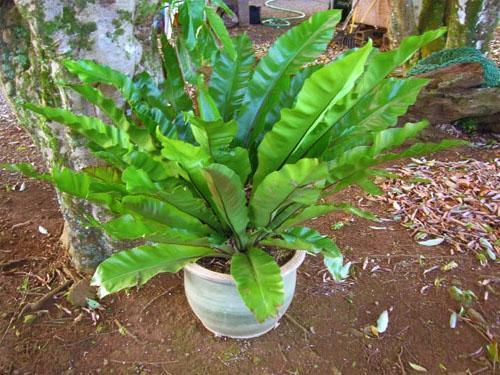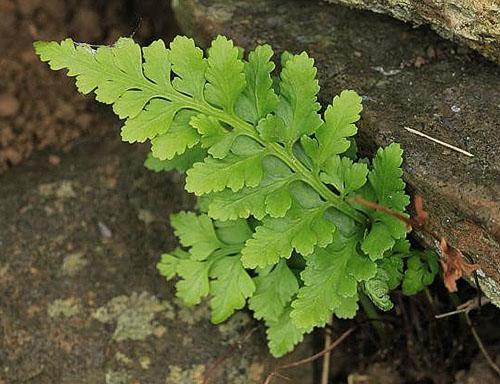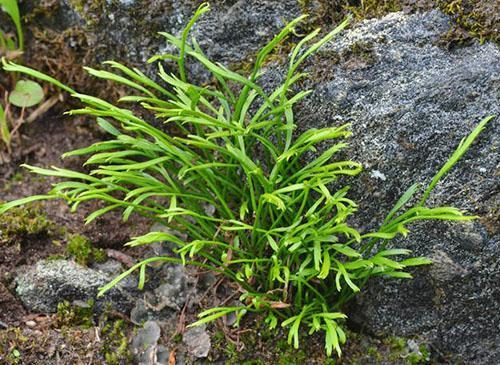Asplenium varieties popular among gardeners
 Representatives of the Kostentsov or Aspleniev family, which unites almost seven hundred species of ferns, are distributed throughout the world. Aspleniums include epiphytes, lithophytes, and terrestrial species.
Representatives of the Kostentsov or Aspleniev family, which unites almost seven hundred species of ferns, are distributed throughout the world. Aspleniums include epiphytes, lithophytes, and terrestrial species.
The attractive appearance of the foliage of these plants made Aspleniums the subject of interest for indoor florists. In addition to the species found in nature, among the popular asplenium varieties among flower growers, there are unique plants on the windowsills that delight the eyes only thanks to breeders.
Asplenium black (A. adiantum-nigrum)

The rosette of a perennial species, unpretentious to growth conditions, consists of double-pinnate, openwork leaves of an almost triangular shape. Leaf segments are pointed, diamond-shaped or trapezoidal, incised, asymmetrical. Leaf petioles drooping, brown or brownish green as they approach the top of the leaf. Petioles of black asplenium are covered with sparse hair. Spores ripen on the back of the leaves.
Asplenium northern or bifurcated (A. septentrionale)
 You can recognize the northern or bifurcated Asplenium by the dense bunches formed by the plant in small areas of fertile soil between the stones. The fern naturally lives on the northwest coast of North America, in parts of Asia and in Europe.
You can recognize the northern or bifurcated Asplenium by the dense bunches formed by the plant in small areas of fertile soil between the stones. The fern naturally lives on the northwest coast of North America, in parts of Asia and in Europe.
A characteristic feature of this asplenium variety shown in the photo is thin, grass-like leaves. The leaf plates are rather hard and leathery. At the same time, the height of the fern is quite small - only 5–10 centimeters.
In the wild, you can find three subspecies of the plant:
- Caucasicum;
- Rehmanii;
- Sertentrionale.
 In all varieties of northern asplenium, the leaves are divided into two parts, and at the ends are additionally dissected, like the tongue of a snake, which gave rise to the scientific name of the plant. Fern rhizome is strong, short, reaching 1 mm in diameter and covered with scales.
In all varieties of northern asplenium, the leaves are divided into two parts, and at the ends are additionally dissected, like the tongue of a snake, which gave rise to the scientific name of the plant. Fern rhizome is strong, short, reaching 1 mm in diameter and covered with scales.
Asplenium montanum or mountain (A. montanum)
 One of the most popular varieties of Asplenium among flower growers of the world is known for easily forming hybrids with closely related plants, also included in the Asplenyev family and having a similar habitat.
One of the most popular varieties of Asplenium among flower growers of the world is known for easily forming hybrids with closely related plants, also included in the Asplenyev family and having a similar habitat.
The fern is considered endemic and is found naturally only in the eastern United States. Its range extends to the Appalachians in Vermont, there are separate populations in the Ohio Valley. The species was first discovered and described in 1810. The best place for this type of growth is to apply acidic soil in cracks in sandstone cliffs.
 The Asplenium Montanum pictured is a small evergreen fern that forms rosettes of bluish-green leaves. Fern rhizomes are superficial, under the soil are located almost under the surface itself.
The Asplenium Montanum pictured is a small evergreen fern that forms rosettes of bluish-green leaves. Fern rhizomes are superficial, under the soil are located almost under the surface itself.
Petioles below the leaf blade are dark brown in color, becoming almost black or purple at the base. To the leaf blade, the color changes to green, a small pile is noticeable on the back side. Leaves are dense, leathery and perfectly smooth. They have a triangular shape and are repeatedly dissected.
 The leaf consists of 4 - 10 pairs of roughly excised along the edge. The largest segments are located at the base of the leaf; as they move towards the apex, their sizes become noticeably smaller. The veins on the sheet are practically indistinguishable.
The leaf consists of 4 - 10 pairs of roughly excised along the edge. The largest segments are located at the base of the leaf; as they move towards the apex, their sizes become noticeably smaller. The veins on the sheet are practically indistinguishable.
Asplenium ruta-muraria (A. ruta-muraria)
 This type of fern, sometimes grown as a houseplant, has many names. Asplenium ruta-muraria, wall-bone or wall-root, wall-bone or Wall-ryu. Asplenium grows both in the USA and is widely settled in Europe. The species refers to plants that live exclusively on limestone cliffs or man-made white stone walls.
This type of fern, sometimes grown as a houseplant, has many names. Asplenium ruta-muraria, wall-bone or wall-root, wall-bone or Wall-ryu. Asplenium grows both in the USA and is widely settled in Europe. The species refers to plants that live exclusively on limestone cliffs or man-made white stone walls.
 The height of the asplenium varies from 5 to 15 cm. The plant has a short, dark-scaled rhizome and dissected openwork leaves. The stalks of the fern are green or gray, the leaves are dense, triangular. Segments of the first and second order have their own short petioles and are extremely diverse in shape.
The height of the asplenium varies from 5 to 15 cm. The plant has a short, dark-scaled rhizome and dissected openwork leaves. The stalks of the fern are green or gray, the leaves are dense, triangular. Segments of the first and second order have their own short petioles and are extremely diverse in shape.
In summer, globular spores ripen on the underside of the leaves. Moreover, the sporangia contains 64 disputes.
Asplenium breeding (A. nidus)
 The most popular asplenium among flower growers, the varieties of which even connoisseurs amaze with their diversity, is the nesting asplenium with a wide rosette of whole or decorative slightly dissected leaves. A special feature of the species is the cupped shape of the rosette, when the petioles, starting from the center, go above the ground and then rise.
The most popular asplenium among flower growers, the varieties of which even connoisseurs amaze with their diversity, is the nesting asplenium with a wide rosette of whole or decorative slightly dissected leaves. A special feature of the species is the cupped shape of the rosette, when the petioles, starting from the center, go above the ground and then rise.
Asplenium has nidus elongated, often lanceolate leaves. The petioles are short, inconspicuous. Against the background of a light leaf plate, central dark-colored veins stand out brightly.
The inspiration for the selection was the presence of two independent varieties of the asplenium nidus with a whole corrugated leaf plate and leaves repeatedly dissected at the top.
Asplenium Crissie
 The variety of aspleium shown in the photo differs from most fern species in that its leaves at the ends branch many times, becoming, in fact, finger-like. Asplenium has a fluffy dense bowl-shaped rosette. Leaves are thin, leathery, light green in color. Plant height ranges from 25 to 40 cm.
The variety of aspleium shown in the photo differs from most fern species in that its leaves at the ends branch many times, becoming, in fact, finger-like. Asplenium has a fluffy dense bowl-shaped rosette. Leaves are thin, leathery, light green in color. Plant height ranges from 25 to 40 cm.
Asplenium Amy
 While similar to the previous variety, Amy Asplenium differs somewhat in the shape of the foliage, the lateral edges of which are almost parallel. The “fingers” at the edges of the leaves are also much thinner.
While similar to the previous variety, Amy Asplenium differs somewhat in the shape of the foliage, the lateral edges of which are almost parallel. The “fingers” at the edges of the leaves are also much thinner.
Asplenium nidus Philippines Hybrid
 But the Filipino nesting Asplenium hybrid, which appeared at the disposal of flower growers quite recently, is already difficult to confuse with another plant of this species. Here, branching of the leaf begins almost at the petiole, therefore, towards the top, the leaf becomes repeatedly dissected, wide and very decorative. As you can see in the photo of this Asplenium variety, the color of the leaves at the base is dense green, towards the edges the intensity decreases slightly.
But the Filipino nesting Asplenium hybrid, which appeared at the disposal of flower growers quite recently, is already difficult to confuse with another plant of this species. Here, branching of the leaf begins almost at the petiole, therefore, towards the top, the leaf becomes repeatedly dissected, wide and very decorative. As you can see in the photo of this Asplenium variety, the color of the leaves at the base is dense green, towards the edges the intensity decreases slightly.
Asplenium fimbriatum (A. nidus Fimbriatum)
 If the previous varieties of Asplenium are the result of painstaking work of breeders, then Asplenium fimbriatum, which is loved and recognized by flower growers around the world, is a variety of natural origin.
If the previous varieties of Asplenium are the result of painstaking work of breeders, then Asplenium fimbriatum, which is loved and recognized by flower growers around the world, is a variety of natural origin.
Asplenium nidus Fimbriatum is distinguished by the edge of the leaf cut from the base to the top, and in the wild, the fern can be found in the tropical zone of Africa, Australia and Polynesia.
Asplenium Osaka
The Osaka Asplenium is an attractive fern with a domed crown, 40 to 60 cm high and the same width. The edges of the light green lanceolate leaves are wavy. Closer to the ground, the veins are dark in color; as they move to the pointed edge, the color changes to yellowish-green or whitish.
 At home, Asplenium Osaka needs regular watering and grows well both in partial shade and on windows where the sun appears in the afternoon. The optimum temperature for keeping this fern species in the summer is 18-25 ° C, during the rest period the air should be 3-5 ° C cooler.
At home, Asplenium Osaka needs regular watering and grows well both in partial shade and on windows where the sun appears in the afternoon. The optimum temperature for keeping this fern species in the summer is 18-25 ° C, during the rest period the air should be 3-5 ° C cooler.
Asplenium Victoria
 Compared to the Asplenium Osaka, the Victoria variety is more compact, and, in addition, the plant has graceful leaves not only with a wavy edge, but a curved, pointed tip.
Compared to the Asplenium Osaka, the Victoria variety is more compact, and, in addition, the plant has graceful leaves not only with a wavy edge, but a curved, pointed tip.
Asplenium Crunchy waves
 Crispy Wave or Asplenium Crispy waves can be the gem of every home collection.Among Western growers, aspleniums with such corrugated foliage are often called "green lasagna", and for the first time an unusual-shaped fern was discovered in the forest by gardener Haruo Sugimoto back in 1961.
Crispy Wave or Asplenium Crispy waves can be the gem of every home collection.Among Western growers, aspleniums with such corrugated foliage are often called "green lasagna", and for the first time an unusual-shaped fern was discovered in the forest by gardener Haruo Sugimoto back in 1961.
A flower grower, interested in the wavy leaves of a light yellowish-green color, tried to breed and improve the plant. It was possible to fix the properties and register the asplenium variety shown in the photo only by the beginning of this century. And until now, the rights to this unique variety belong exclusively to the Sugimoto family from Japan.
Asplenium nidus Supreme Cobra
 Another amazing variety of Asplenium is not yet well known to flower growers, but undoubtedly deserves close attention. From the natural form of asplenium nidus here, the leaves are more like large green ruffles, smoothly rising above the ground and, moreover, beautifully curved at the end.
Another amazing variety of Asplenium is not yet well known to flower growers, but undoubtedly deserves close attention. From the natural form of asplenium nidus here, the leaves are more like large green ruffles, smoothly rising above the ground and, moreover, beautifully curved at the end.
Asplenium Silver Wing
 The Silver Wing asplenium nidus has a small, even rosette of leaves with a silvery color. The leaves are even or slightly wavy, dense, obverse lanceolate. A short petiole and a convex vein throughout the entire leaf plate is light, rigid.
The Silver Wing asplenium nidus has a small, even rosette of leaves with a silvery color. The leaves are even or slightly wavy, dense, obverse lanceolate. A short petiole and a convex vein throughout the entire leaf plate is light, rigid.
Asplenium nidus variegatum
 Among the popular varieties of asplenium among flower growers, there is still no variegated variety of this fern. But the appearance of the plant will undoubtedly make many indoor crop lovers eager to get it into their collection.
Among the popular varieties of asplenium among flower growers, there is still no variegated variety of this fern. But the appearance of the plant will undoubtedly make many indoor crop lovers eager to get it into their collection.
Whole, lanceolate leaves have no corrugated edges or ramifications, but are striking with an almost white background color and bright green veins.